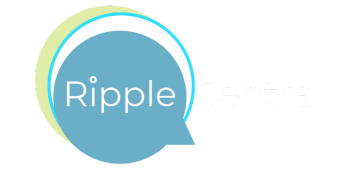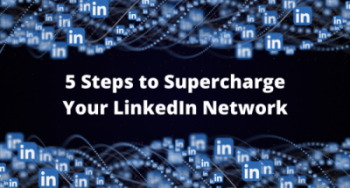5 Steps To Supercharge Your LinkedIn Network
Article originally posted to LinkedIn April 2020
People show up in life exactly when they’re supposed to—with the exception being when they show up on LinkedIn. That’s because the platform makes it too easy to connect.
Over the years, I’ve developed five steps that I follow consistently to supercharge my LinkedIn network. When I train leaders to improve their networking skills, I often mention these five steps.
The first step is that I can’t accept everyone who wants to connect with me. This is often met with a gasp. But by the end of our discussion, leaders understand the results they can get by selectively and proactively building their connections.
So if you want LinkedIn to serve as a vehicle that you can rev up for advice and help at a moment’s notice, follow these 5 Steps to Supercharge Your LinkedIn Network.
Step 1: Don’t Accept Every LinkedIn Invitation
I frequently train leaders at Fortune 500 companies on how to improve their networks. In these training sessions I’ll ask, “How many of you accept every invitation you get on LinkedIn?”
In room after room, most leaders raise their hands. I then ask, “Why do you feel you need to connect with everyone who reaches out?”
The answers boil down to some form of FOMO, or Fear of Missing Out. They’re afraid by not accepting every invitation, they could miss the next big job opportunity, the next big client, or the next rock star talent.
This mindset, though, can do more harm than good. Volume alone is not how you supercharge your LinkedIn network.
Take it from Brian, a member of the executive team for a global company. Brian had a great in-person relationship with his CEO and the two connected on LinkedIn as well. However, one day, Brian noticed that the relationship had turned awkward. He checked LinkedIn only to realize the CEO had disconnected from him. Brian racked his brain for what he might have done wrong but couldn’t come up with anything.
Long story short, months later, Brian was laid off due to outsourcing. The CEO came to the exit interview. Brian took the opportunity to ask what had happened. The answer came as a shock: “I disconnected from you on LinkedIn because you put one of your contacts on me to sell me on a multilevel marketing scheme. I was upset you would abuse our relationship in that way.”
It turns out Brian hadn’t been selective about his LinkedIn connections. Months earlier, he’d accepted an invitation to connect from someone named Sam. He checked Sam’s profile and figured he sounded legit. Little did Brian know that Sam had a side hustle selling vitamins.
Once Sam had successfully connected to Brian, Sam sent the CEO a message saying “Brian really wants the two of us to connect.” Although the CEO didn’t accept the invitation, Sam was relentless about trying to sell his vitamins at scale to the company.
The lesson here is to carefully vet anyone you let into your network. If you get a message saying, “Melinda says we should connect,” verify this with Melinda before accepting the invitation.
Step 2: Only Send Positive Ripples Into Your Network
When you drop a stone in a pond, you can watch the ripples rush to the shore. Once the ripples hit the shoreline, they ripple back to the original source of the energy, which is the spot where you dropped the stone.
Similarly, there is a Ripple Effect that operates when you network. Every connection you make sends energy into the universe that ultimately returns to you. When you make LinkedIn connections, you send positive or negative ripples through your network. You never know how far or how deep these ripples may go, but have no doubt, they’ll always ripple back to you in some way.
Let’s imagine that someone in my network messages me and says, “Steve, I see you are connected to Nina. Can you introduce us?” If I reply, “Oh sorry, I really don’t know who Nina is” or “I don’t feel comfortable asking Nina for a favor,” then I’ve just sent a negative ripple through my network.
On the other hand, if I know Nina and I’ve worked to develop our relationship, then I’m perfectly comfortable making the introduction. And when these two people in my carefully-cultivated network connect, I send a positive ripple through my LinkedIn network.
The more positive ripples I create, the more good things ultimately return to me, the source of the ripples.
Step 3: Build a Collection of Resources
I’m committed to building a relationship with each and every person in my LinkedIn network. That’s why I’m so selective, and I qualify the invitations I do accept.
If I’m going to be the person who can help others find what they need, I’ve got to build a strong network around core people I trust. I look at the people in my LinkedIn network as a collection of resources with loads of experience and practical expertise. My network includes a cutting-edge digital marketer, an award-winning poet and a brilliant software engineer. With representatives from a variety of fields, I’m in a great position to help people access the resources they need.
But I won’t accept anyone into my network just because they have a high profile. I’ll search for as much information as I can about each person seeking to connect with me. I want to know who each person is personally and professionally.
First, I need to know if this is the type of person willing to help others. I can usually determine that by checking the Recommendations section at the bottom of a person’s LinkedIn profile. I like to see that they’ve given at least as many recommendations as they’ve received.
Second, I’ll look at my potential connections’ social media profiles to get a sense of what they feel comfortable putting in public view. This gives me a good idea of what I’m getting into if I commit to deepening our relationship.
When I do accept people into my network, the first thing I do is ask how I might help advance their career goals. This leads me to the next step to supercharge your LinkedIn network.
Step 4: Proactively Help Your LinkedIn Connections
Because I focus on quality not quantity in building my network, I proactively and routinely review my connections to see who I can help.
Yes, this takes time. But that’s how I build quality relationships. There are people in my LinkedIn network I’ve known for decades and in-person. Our relationships are already deep and solid. When I focus on proactively helping individuals in my network, I’ll concentrate on new connections and people I don’t know quite as well. I look to make introductions that might help my connections advance their career goals. And since I believe information is often more valuable than money, I’ll search out content that answers urgent questions for my contacts.
Let’s say someone in my network was recently laid off. I won’t wait for that person to ask me for help. I’ll go out of my way to make introductions and send articles containing information about job openings in that person’s industry.
I know that if I bring value to my connections, when the day comes that I really need help, I’ll get it.
Step 5: Routinely Cull the Herd
If you want to keep your LinkedIn network active and energized, you’ll need to routinely disconnect from some contacts. I do this quarterly. I mark the dates on my calendar to review each person in my network. When I do this review, I ask myself, “Am I still committed to putting in the time and effort to develop the relationship?” I look for people who I can’t find a way to help personally or professionally. I look for people I haven’t communicated with at all for three years. And I look for connections I’ve helped frequently but who don’t seem interested in returning the favor. When I find these people, I disconnect. Like everyone, I only have a limited amount of time in my day. When I cull the herd each quarter, I make room to invest my time in building new connections.
Remember, your network is the one true asset you own and you can take anywhere with you in your career. But it’s only as strong as the time, energy and focus you put into it.
So here’s the bottom line: If you want a LinkedIn network that is a powerhouse tool for your career, you need to approach it proactively and selectively. Once you have a lean and active network, you can invest your time in sending positive ripples through it. It won’t take long before you reap rewards that come from supercharging your LinkedIn network.
Ripple On!!!

